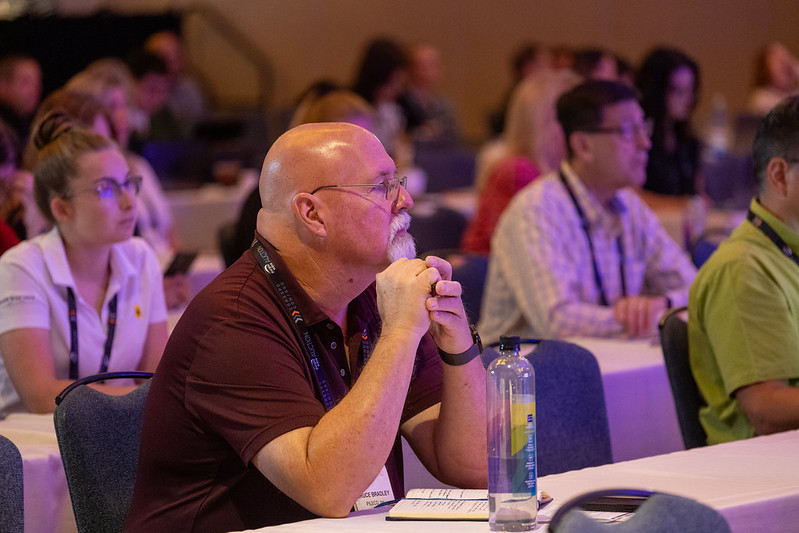By Julie Davis, AEM VP of People Strategy —
Over the past five years, I’ve spent countless hours researching workforce development strategies for manufacturing. I’ve engaged AEM members to uncover the challenges they face, as well as employ the strategies and tactics they need to move the needle on workforce recruitment and retention.
My work at AEM is unique in that it’s provided me numerous opportunities to interact with a significant cross-section of the manufacturing industry. I see who’s winning the war for talent – and who isn’t. I’ve talked to enough people to develop an understanding of who is making progress and – perhaps more importantly – why they are in a position to succeed in the long term.
When I ask organizational leaders about what they’re doing in the area of workforce development, I often receive one of two responses:
“We’re doing everything we can do.”
Or…
“Well, I’m not sure. We’re trying this and that, and then we did this, and it was a little crazy, but it worked.”
Once I hear one of the two statements, I know exactly where the conversation is headed.
The winners in the war for talent are curious. They are willing to think outside the box, and their talent strategy lives alongside their business strategy at the c-suite table.
Workforce is often cited as a top issue for manufacturers today. It keeps company leaders up at night, and for good reason. However, when it comes to engaging in workforce strategy, many of these leaders don’t possess the requisite legacy knowledge to approach it effectively.
Prior to the past decade or so, employers were able to gain access to enough talent. Hiring practices didn’t need to change. That’s no longer the case. The good news is a wealth of strategies exist to help leaders attract the workforce of tomorrow. The challenging task ahead, however, is leaders will need to be intentional in executing those different strategies and be able to adjust to the labor market of today.
Want more information on best practices, tools, programs, and resources to help attract and retain the right talent? Visit AEM’s Workforce Solutions Toolkit.
What’s Causing This Change?
Population Mathematics
Three generations comprise the entirety of the workforce most of the time. Typically, one generation may be cycling in while another is cycling out, but the base is about three generations deep. During the working lives of many leaders today, these generations have been:
- Baby Boomers (75.4 million)
- Generation X (65.9 million)
- Millennials (76.8 million)
The three groups total 218 million people. However, in 2025, those three generational brackets will switch. Generation X through Generation Z (67 million) will make up the vast majority of our labor market, and they will total 210 million people. The numbers don’t lie – that’s 8 million less accessible workers for employers to draw from in the future.
Decline of Labor Force Participation Rates of Prime-Age (25-54) Men
Since the 1980s, the labor force participation rates of men between the ages of 25-54 have steadily decreased. Increasingly, males in this age group are opting for part-time employment or dropped out of the traditional labor market completely. The following statistics indicate the impact of the decline:
- The number of prime-age men who willingly opted for part-time jobs jumped from 6 million in 2007 to nearly 8 million in 2019.
- A 2015 research report indicates 860,000 prime-age men were absent from the labor force due to opioids.
- By 2030, an estimated $68 trillion is expected to be transferred from the Baby Boomer generation to Millennials, making the latter the wealthiest generation in history.
Historically, men have been the primary workforce in manufacturing. That’s still the case today. However, the decline of participation by prime-age men supports a strategy on the part of manufacturers to redirect hiring efforts toward less-represented populations.
Overall Population Trends
The population of adults ages 55 and above continues to grow, while the population of younger adults, ages 16-24 entering the workforce is not keeping pace. Birth rates have been steadily declining in the U.S., starting around the 1970’s and the combination of low birth rates, low workforce participation, and longer lifespans means that two-thirds of the US population could be financially dependent on the remaining one-third in a little more than 70 years.
What Can Be Done?
Similar to creating a market strategy for a forecasted market downturn, when manufacturers understand the labor demographics ahead, they can make strategic workforce decisions that align with business strategy.
Begin with Retention
It’s not enough to put the right people in the right spots. It’s essential to business continuity they remain in place. After all, employee turnover costs money and time. Employers must understand general expectations and adjust as much as possible (I.e., providing flexible workplaces, fostering organizational transparency, and committing to employee development).
Technology will only continue to move forward, so manufacturers must respond by identifying how to most effectively upskill, reskill, or new-skill employees. That means figuring out what can be trained in-house and what requires outside assistance or third-party collaboration.
Answer the Automation Question
It’s clear fewer people and more competition for workers should be expected moving forward. That’s not only the case within manufacturing, but other sectors as well. Younger generations are much more willing to change career paths. So, that begs the question: At what point will the cost of automation offset the loss of production due to workforce challenges?
Become Intentional with Knowledge Transfer
Data shows 10,000 people turn 65 years old every day. Next year, that number is projected to increase to over 11,000 per day. The last loyal generation is leaving the workforce, and unless manufacturers are intentional, in five to 10 years, their respective knowledge legacies will be gone. And while knowledge transfer feels intimidating, a spectrum of engagement exists in which manufacturers can participate. The important thing is to get started identifying key positions and beginning to ask questions prior to the transition of too many job roles.
Several books offer insights to how to approach this with intentionality. "Critical Knowledge Transfer: Tools for Managing Your Company’s Deep Smarts” is one I’ve found most helpful, as it offers both practical strategies and questions.
Think About Targeting Talent Pools
When recruiting or doing outreach, manufacturers must break down the population into talent pools. (Ex. Women, veterans, minorities, second chance, underemployed, unhappily employed, youth, etc.) Who’s missing from the production floor? How can a job posting be written with the proper audience in mind? Where should a position be posted to target a specific audience? Organizations should then target portions of the population that are underrepresented within their company, speak directly to them and – most importantly – invite them to apply for open positions.
Do Things Differently
It’s time for organizations to educate themselves about skills-based hiring. Skills-based hiring prioritizes abilities, knowledge, and practical experience over education or past employment history. It helps companies:
- Broaden their hiring net
- Increase the chances of finding the right fit for a specific position
- Foster increased employee retention and engagement
- Cultivate a more diverse candidate pool
- Create a skills web through job descriptions that may help internal career pathways
It requires a bit of work to get started, but ultimately, it’s worth it in order to build a solid foundation for future hiring and retention practices.
What’s the Takeaway?
When it comes to workforce development, “tried and true” strategies and tactics aren’t going to cut it anymore. And the more labor demographics continue to change, the more challenging it will be for companies to see a return on what’s worked for them in the past.
However, I’m here to say it’s possible to have workforce strategy align with business strategy. But in order to be successful, manufacturers will have to take a long, hard look at the current labor data, develop a plan of attack, and follow through on the adjustments they make moving forward.
Subscribe to the AEM Industry Advisor for more perspectives from AEM staff.





